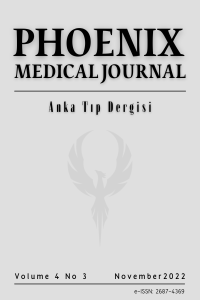Abstract
Amaç: Acil servise delici çivi yaralanması ile başvuran hastaların demografik ve klinik özelliklerini incelendik. Riskli meslek grupları ve çalışma alanlarının yaralanma bölgesiyle olan ilişkisini araştırdık.
Gereç ve Yöntem: Çalışmamız retrospektifti. 1 Ocak 2018-31 Aralık 2018 tarihleri arasında acil servise başvuran hastaların demografik ve klinik özellikleri, meslekleri, yaralanmanın gerçekleştiği alan ve yara yeri hasta dosyalarından kaydedildi. Ayak tabanı yaralanması 3 anatomik bölgeye ayrıldı. Verilerin analizinde tanımlayıcı istatistik ve ki-kare testi kullanıldı. İstatistiksel anlamlılık p<0.05 olarak belirlendi.
Bulgular: Çivi yaralanması olan 106 hasta çalışmaya alındı. Hastaların 79 (%74.5) erkekti ve yaş ortalaması 36,25±16,71 idi. Yaralanmanın gerçekleştiği alanlar en fazla kişisel bahçeler (%29,2) ve inşaat alanları (%29,2) idi. En yaygın meslek inşaat işçiliği idi (%29,2). Yaralanma yeri en çok ayak idi (%85,8). Ayak yaralanması en çok Bölge 1’de görüldü (%68).
Sonuç: Çiviye bağlı yaralanmalar en sık erkeklerde, orta yaş grubunda ve ayak bölgesinde görüldü. Ayak yaralanmaları en sık Bölge 1 idi.
Keywords
References
- Mark E, Viktor B, Yoav M. Plantar puncture wounds in children: analysis of 80 hospitalized patients and late sequelae. Isr Med Assoc J. 2003;5(4):268-271.
- Patzakis MJ, Wilkins J, Brien WW, Carter VS. Wound site as a predictor of complications following deep nail punctures to the foot. West J Med. 1989;150:545-547.
- Laughlin TJ, Armstrong DG, Caporusso J, Lavery LA. Soft tissue and bone infections from puncture wounds in children. West J Med. 1997;166(2):126-128.
- Fitzgerald RH, Cowan JDE. Puncture wounds of the foot. Orthop Clin North Am. 1975;6:965-972.
- Schwab RA, Powers RD. Conservative therapy of plantar puncture wounds. J Emerg Med. 1995;13(3):291-295.
- Miron D, Raz R, Kaufman B, Fridus B. Infections following nail puncture wound of the foot: case reports and review of the literature. Isr J Med Sci. 1993;29(4):194-197.
- Verdile VP, Freed HA, Gerard J. Puncture wounds of the foot. J Emerg Med. 1989;7(2):193-199.
- Fernando DMG, Ekanayake EMKB. Nail Gun Suicide: An Atypical Case Report and Review of the Literature. Am J Forensic Med Pathol. 2021;42(3):267-274.
- Carrillo-Ruiz JD, Juarez-Montemayor V, Mendez-Viveros A, Frade-Garcıa A, Bolanos-Jimenez R. Skull stab wound from a metal railroad nail perforating the right frontal lobe. Brain Inj. 2013;27(7-8):973-977.
- Siu A, Wong TW, Lau CC. Survey on plantar puncture injury in the emergency department. Hong Kong J Emerg.Med. 2000;7:197-205.
- Rubin G, Chezar A, Raz R, Rozen N. Nail Puncture Wound Through a Rubber-Soled Shoe: A Retrospective Study of 96 Adult Patients. J Foot Ankle Surg. 2010;49:421–425.
Abstract
Aim: We examined the demographic and clinical characteristics of patients who presented to the emergency department with nail-related injury. We investigated the relationship between the risky occupation and work areas and the injury site.
Method: Our work was retrospective. The patients who admitted to the emergency department between 1 January 2018 and 31 December 2018 were screened. Demographic and clinical characteristics, occupations, the area where the injury occurred and the wound site of the patients were recorded from the patient files. The foot injury was divided into 3 anatomical regions. Descriptive statistics and chi-square test were used for the analysis of the data. P value <0.005 was considered significant.
Results: We examined 106 cases with the nail-related injury.. The mean of ages was 36.25 ± 16.71 and 79 (74.5%) of 106 patients were male. The area was mostly personal gardens (29.2%) and construction site (29.2%). The most common occupation was construction work (29.2%). The wound site was mostly on the foot (85.8%). Zone 1 injury was the most common foot injury (68%).
Conclusion: The nail-related injuries were mostly common in men, in the middle-age and on the foot. The foot injuries were common in Zone 1.
Keywords
References
- Mark E, Viktor B, Yoav M. Plantar puncture wounds in children: analysis of 80 hospitalized patients and late sequelae. Isr Med Assoc J. 2003;5(4):268-271.
- Patzakis MJ, Wilkins J, Brien WW, Carter VS. Wound site as a predictor of complications following deep nail punctures to the foot. West J Med. 1989;150:545-547.
- Laughlin TJ, Armstrong DG, Caporusso J, Lavery LA. Soft tissue and bone infections from puncture wounds in children. West J Med. 1997;166(2):126-128.
- Fitzgerald RH, Cowan JDE. Puncture wounds of the foot. Orthop Clin North Am. 1975;6:965-972.
- Schwab RA, Powers RD. Conservative therapy of plantar puncture wounds. J Emerg Med. 1995;13(3):291-295.
- Miron D, Raz R, Kaufman B, Fridus B. Infections following nail puncture wound of the foot: case reports and review of the literature. Isr J Med Sci. 1993;29(4):194-197.
- Verdile VP, Freed HA, Gerard J. Puncture wounds of the foot. J Emerg Med. 1989;7(2):193-199.
- Fernando DMG, Ekanayake EMKB. Nail Gun Suicide: An Atypical Case Report and Review of the Literature. Am J Forensic Med Pathol. 2021;42(3):267-274.
- Carrillo-Ruiz JD, Juarez-Montemayor V, Mendez-Viveros A, Frade-Garcıa A, Bolanos-Jimenez R. Skull stab wound from a metal railroad nail perforating the right frontal lobe. Brain Inj. 2013;27(7-8):973-977.
- Siu A, Wong TW, Lau CC. Survey on plantar puncture injury in the emergency department. Hong Kong J Emerg.Med. 2000;7:197-205.
- Rubin G, Chezar A, Raz R, Rozen N. Nail Puncture Wound Through a Rubber-Soled Shoe: A Retrospective Study of 96 Adult Patients. J Foot Ankle Surg. 2010;49:421–425.
Details
| Primary Language | English |
|---|---|
| Subjects | Emergency Medicine |
| Journal Section | Research Articles |
| Authors | |
| Publication Date | November 10, 2022 |
| Submission Date | July 28, 2022 |
| Acceptance Date | September 6, 2022 |
| Published in Issue | Year 2022 Volume: 4 Issue: 3 |

Phoenix Medical Journal is licensed under a Creative Commons Attribution 4.0 International License.

Phoenix Medical Journal has signed the Budapest Open Access Declaration.


